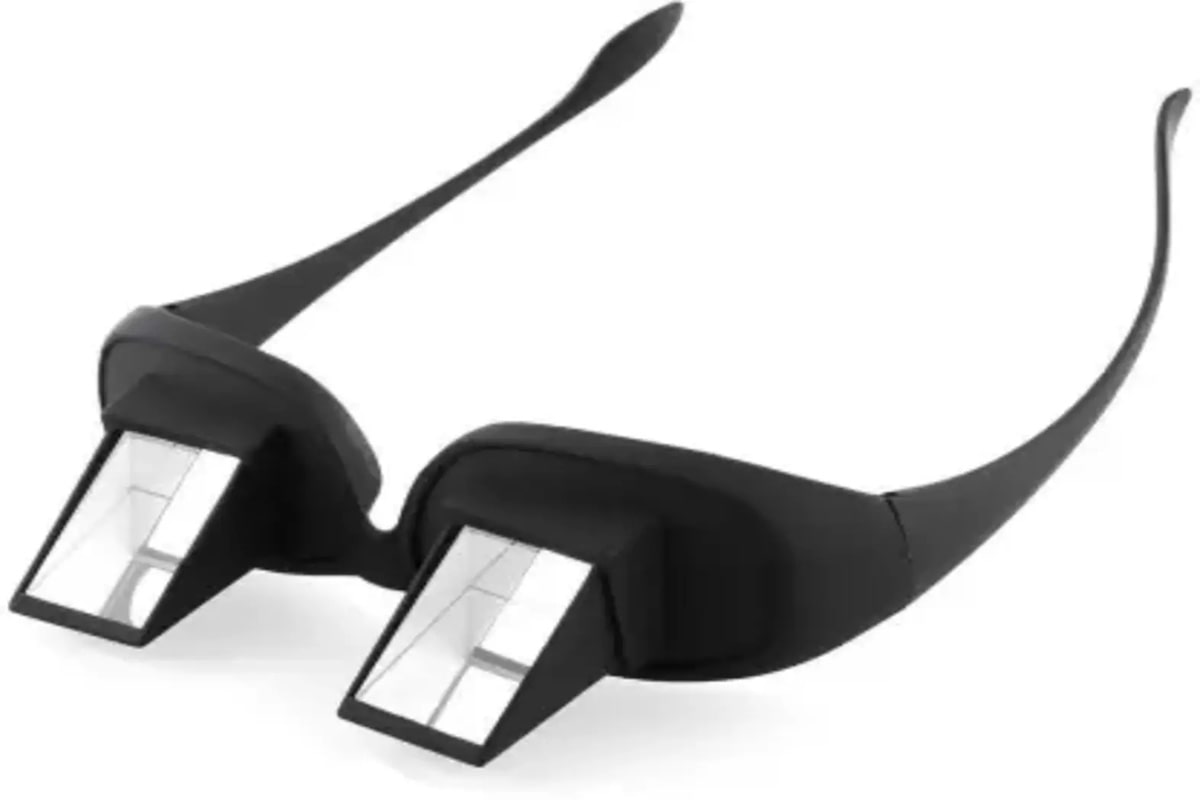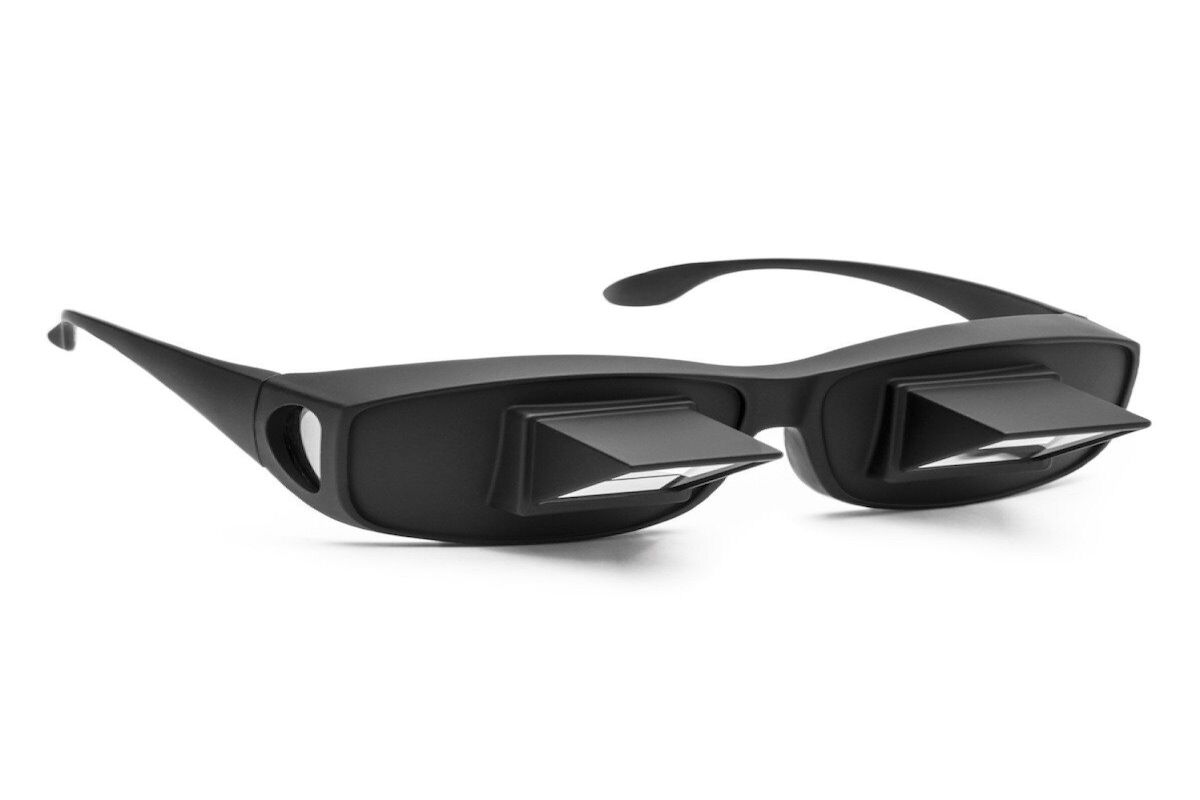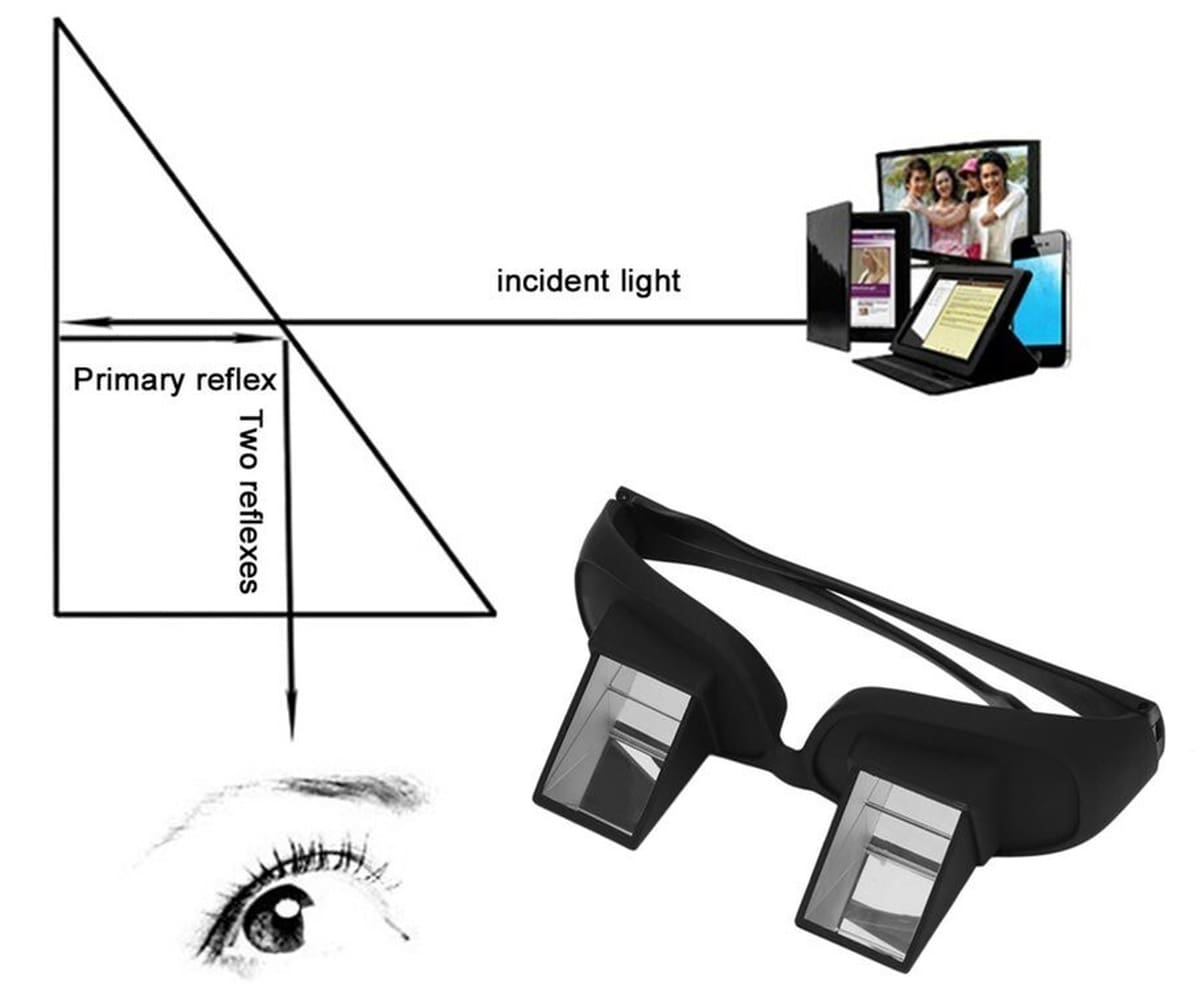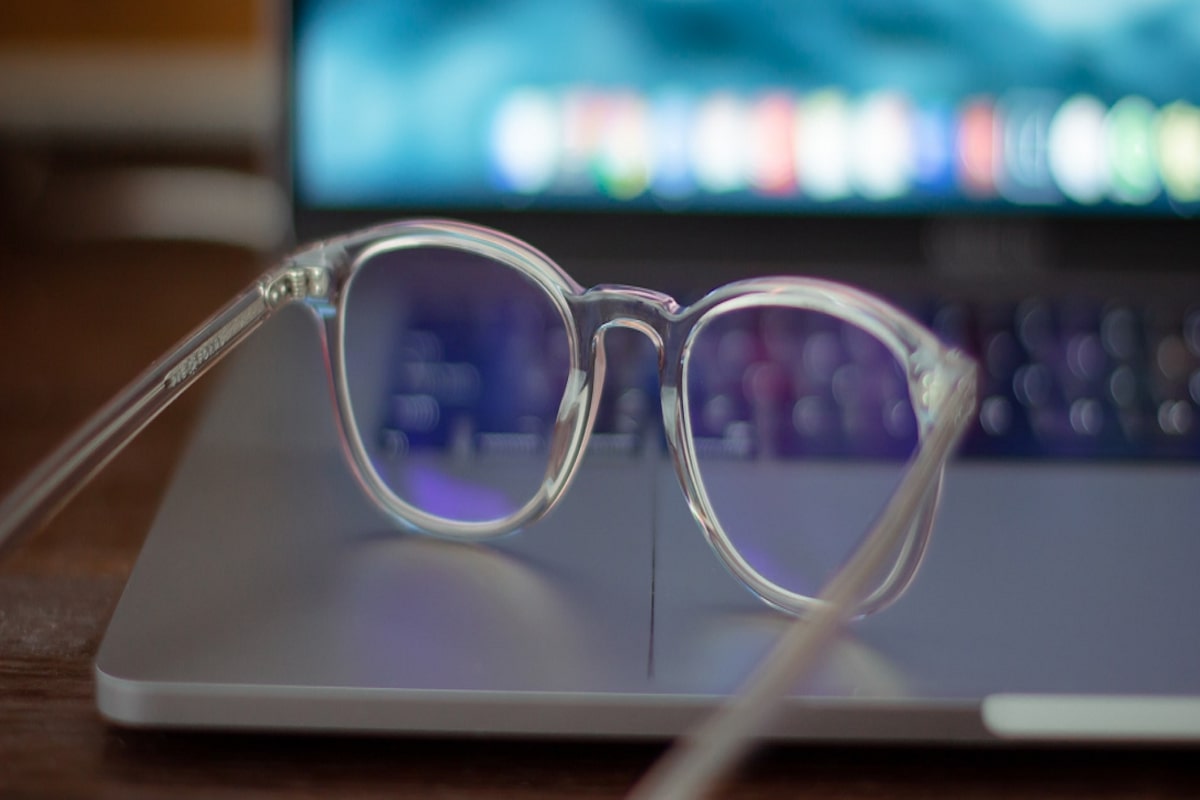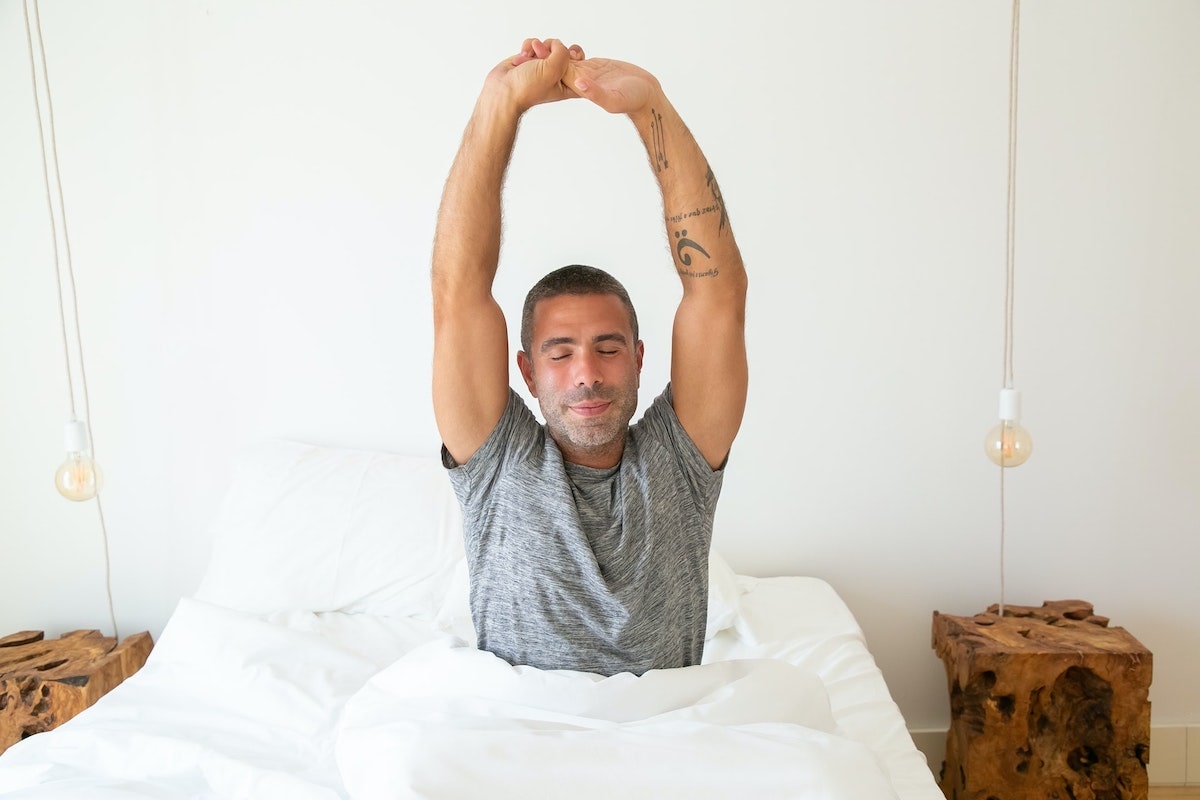Lazy Glasses: What Are They?
Do you enjoy reading or watching TV in bed but find yourself constantly adjusting your position? In most cases, this might be because you’re experiencing neck and back pain from having to tilt your head.
There’s a potential solution to this, and it has taken TikTok by storm: lazy glasses.
These innovative specs let you watch TV or read in bed without even having to lift your head off the pillow. Let’s explore how they work, their pros and cons, and whether they’re worth the investment.
What are lazy glasses?
Lazy glasses are designed to let you lie flat on your back and still see the screen or page without moving your neck upward.
There are two main types of lazy glasses. The most common type is the periscope-style lazy glasses, which use two angled mirrors to reflect the image or text from a screen or page to your eyes. These are more suited for people who need a wider angle of reflection or need to view larger screens or pages.
Meanwhile, prism-style lazy glasses use a single prism to reflect images or text to your eyes. The prism is positioned at a specific angle so that the light from the screen or page is refracted toward your eyes, even if the glasses are not facing you directly.
Prism-style glasses are typically more compact and lightweight than periscope-style glasses. They’re a popular option for those who want a more streamlined and portable solution for hands-free viewing in bed.
How lazy glasses work
As you can probably tell by now, lazy glasses use mirrors or prisms to function. Prisms, which are made of triangular pieces of glass or plastic, can bend light by splitting it into component colors and refracting it at an angle.
They’re angled to ensure an image or text appears upright to you, even though it’s reflected off a surface not directly in front of you.
Generally, this means you can lie flat on your back and still see the screen or page without looking up. Apart from keeping your neck comfortable, reading or watching TV with prism glasses can also reduce eye strain and fatigue. Additionally, it’s a lifesaver for those with limited mobility who may have difficulty sitting up to watch TV or read.
However, excessive screen time can lead to eye strain. The same is true for lazy glasses; prolonged use can cause eye strain, neck and facial tension, and fatigue.
That’s where blue light glasses come in handy for many people. By reducing the amount of blue light that enters your eyes, these glasses can help protect your eyes from digital eye strain. If that’s your jam – go check out Mouqy’s collection of affordable blue light glasses.
How lazy glasses compare with other solutions
People who struggle to see small text up close usually rely on traditional reading glasses or bifocal lenses. However, looking at the screen or page often requires tucking your head or neck. As a result, this can exacerbate neck pain and strain because you need to crane your head even further.
On the other hand, lazy glasses allow you to lie flat on your back and read or scroll without any additional strain on your neck or back.
Tablet stands or laptop trays are another option for hands-free viewing. However, while they can effectively reduce neck strain, you still need to sit up in bed or use a pillow to prop yourself up. This can be uncomfortable for extended periods and may not be ideal for people with limited mobility.
Are there any downsides to lazy glasses?
While lazy glasses can be helpful to your daily routine, there are potential drawbacks and limitations.
One of the main issues with lazy glasses is their weight and comfort. Some can be bulky or heavy, which can be uncomfortable for extended periods of use. Hence, it’s important to find a pair that fits well and is lightweight.
Another factor to consider is the importance of proper usage and posture. Lying completely flat on your back for extended periods can also cause discomfort or strain in other parts of your body, such as your hips or lower back. Taking breaks and stretching regularly is essential to avoid this.
Additionally, lazy glasses may not be suitable for people with certain eye conditions such as glaucoma or cataracts. Furthermore, if you wear corrective lenses, you may need to find a pair of lazy glasses that can be worn over your glasses or contacts as lazy glasses don’t have a prescription.
Choosing and using lazy glasses effectively
Selecting the right lazy glasses
When choosing a pair of lazy glasses, consider the size of the screen or page you’ll be viewing, their comfort level, and whether or not you wear corrective lenses.
Periscope-style lazy glasses are ideal for those who prefer wider angles, while prism-style glasses are often lighter and more compact. If you need flexibility, you can opt for ones with adjustable angles.
Additionally, if you wear glasses or contacts, look for ones that can be worn over your corrective lenses.
Using lazy glasses properly
When using lazy glasses, ensure they fit comfortably and securely on your head. Make sure you can adjust the glasses’ angle to your liking, depending on the position you’re lying in and the screen or page you’re viewing.
Maintaining good posture while using the glasses also matters, and that means avoiding lying completely flat on your back for extended periods. Use pillows to support your neck and head, and take breaks to stretch and adjust your position regularly.
Maintaining your lazy glasses
Cleaning your lazy glasses regularly is essential for keeping them in good condition. For dust or smudges, use a soft cloth or lens cleaning solution. Additionally, you can prevent damage by storing them in a protective case when not in use.
A convenient solution with proper usage considerations
Despite what the name suggests, lazy glasses aren’t only for the “lazy”, but also an innovative and convenient solution for anyone who wants to read or watch TV in bed without neck and back pain. For those who have mobility issues, it can also greatly improve their quality of life.
However, there are potential drawbacks and limitations, including eye strain and discomfort in the hips or lower back if worn for too long.
When choosing lazy glasses, consider the size of the screen or page you’ll be viewing, their comfort level, and whether or not you wear corrective lenses. Proper usage and maintenance, maintaining good posture, and cleaning the glasses regularly can also help you get the most out of this unique type of glasses.

Written by:
Angie Garcia












